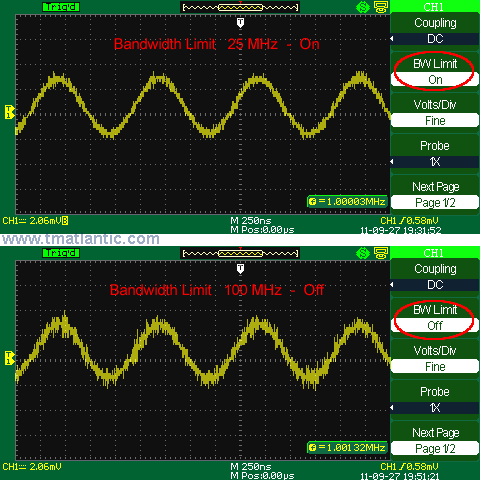| www.tmatlantic.com
Test & Soldering Equipment On-line Store |
|
D.E.V.I.C.E. (Wiki)Calculators Services |
|||||
Filter by first letter
|
Bandwidth limitBandwidth limit is an oscilloscope mode when its upper frequency of the bandwidth intentionally reduces to the frequency which is several times lower. This mode allows making “signal/noise” ratio better for repetitive input signals with maximum frequency in the spectrum which doesn’t not exceed the oscilloscope limitation frequency. Meanwhile all parasitic spectrum components with higher frequencies (noises, pulse noises, leakage etc.) are excluded. It’s especially important for weak signals. In the animated picture below you can see the following: when the bandwidth limit mode is on 25 MHz (the first picture) “signal/noise” ratio for input signal with the frequency of 1 MHz is much better comparing to the second picture where the bandwidth is full and equals 100MHz.
El límite de ancho de banda es un modo de osciloscopio cuando su frecuencia superior del ancho de banda se reduce intencionalmente a la frecuencia que es varias veces menor. Este modo permite hacer “signal/noise” relación mejor para señales de entrada repetitivas con frecuencia máxima en el espectro que no excede la frecuencia de limitación del osciloscopio. Mientras tanto, todos los componentes del espectro parásito con frecuencias más altas (ruidos, ruidos de pulso, fugas, etc.) están excluidos. Es especialmente importante para señales débiles.. En la imagen animada a continuación, puede ver lo siguiente: cuando el modo de límite de ancho de banda está en 25 MHz (la primera imagen), la relación "señal/ruido" para la señal de entrada con la frecuencia de 1 MHz es mucho mejor en comparación con la segunda imagen donde el el ancho de banda está lleno y es igual a 100 MHz.
|
Site mapPrivacy policyTerms of Use & Store PoliciesHow to BuyShippingPayment




|


























